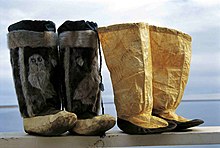User:AlaskanWookiee1/sandbox
This article needs additional citations for verification. (September 2010) |

Mukluks or Kamik (singular: kamak, plural: kamiit) are a soft boot traditionally made of reindeer skin or sealskin and were originally worn by Arctic aboriginal people, including the Inuit and Yupik. The term mukluk is often used for any soft boot designed for cold weather and modern designs are often similar to high-top athletic shoes. The word "mukluk" is of Yupik origin, from maklak, the bearded seal, while "kamik" is an Inuit word. In the Inuipiaq language the "u" makes an "oo" sound, and so the spelling "maklak" is used with the same pronunciation.

Another type of boot, sometimes called an Inuit boot, originating in Greenland and the eastern part of Alaska, are made by binding them with animal cartilage and have a centre seam running down to the foot of the boot.
Mukluks weigh little and allow a person to move very quietly, quickly, and allows the wearer to move in them without taxing the body any more than maybe a tennis shoe or other light footwear. They may be adorned with pompons, beads, teeth and claws of animals, dyed leather or with scenes or animals drawn on them or weaved into the boot. Normally, the only decorated part is on the top portion of the calf. Hides of different colors or other species can be used for such purposes with the addition of the leather or sinew strips used for the laces. Most of the time they are lined internally with furs that are very short or shaved such as rabbit, fox and raccoon and seal. If you or someone you know has access to a shoe sewing machine, the different designs that can be made are only hampered by your imagination.
The design of the mukluk is used for the industrial manufacture of cold-weather boots, especially paired with a rugged contemporary sole. The key component of its success is its ability to breathe, that is, to allow air exchange. Since these are made from animal hides, they use the naturally occurring sweat pores in most animal hides to perform this function. The holes are usually small enough to allow vapors to escape from the inside to the outside, but they are not large enough to allow liquid to freely flow through them, thus making the vast majority of mukluks weather-proof to a large degree. This is an advantage in extremely cold conditions where perspiration may become a factor in frostbite on your feet. The biggest way for liquid to get into them, is by directly wicking it down your pant leg into the boot. I personally don't wear socks at all in mine until it gets around -10 F., then use a thin pair to about -50 F. when a thicker pair of socks is warranted. At -80 to -90 F. the wool socks are advised to have on your feet. The lack of bulk involved in this type of footwear makes it ideal for almost any situation or climate.
|last = John |first = Long |title = The Complete Hiker |year = 2000 |isbn = 0-07-135818-8}}</ref>
Another kind of mukluk, typically made out of wool or a wool-rayon blend, is knitted with a soft leather sole. Often called 'Slipper Socks", these were the traditional mukluk worn by the people of the Hindu Kush Mountains. These soft mukluks can be worn by ballet dancers in place of leg/foot warmers, for a comfy pair of slippers to warm up your feet at home, or around a warm camp fire during a summer camping trip.
Modern Aboriginal-owned companies continue to make authentic designs that use natural furs and skins.
References[edit]
Category:Traditional footwear Category:Boots Category:Inuit clothing Category:Inuktitut words and phrases

